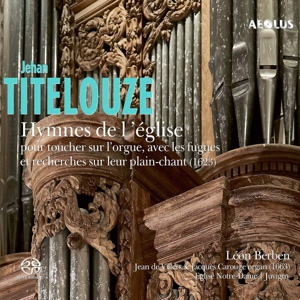
Jehan Titelouze (1563-1633)
Hymnes de l’église
Léon Berben (organ)
rec. 2021, Église Notre-Dame, Juvigny, France
Aeolus AE11341 SACD [2 discs: 117]
Until this new release came along I’d never heard the name Jehan Titelouze. He was a French Catholic priest, composer, poet and organist, who served as a canon and organist at Rouen Cathedral. Praised for his improvisatory skills and virtuoso technique on the organ, he was sought after far and wide as a performer. As a composer he is regarded as among the greatest early Baroque composers of France, and is credited as the first composer of the French organ school. His Hymnes de l’église of 1623, featured in this album, and his Magnificat settings written three years later, are considered his finest achievements.
Léon Berben performs on the historic organ of the Notre-Dame de Juvigny, an instrument which dates from 1663. The challenge for the performer in this music is that it contains no registration indications or ornamentation marks. Berben’s impressive registration choices bring much variety and colour to these marvellous scores and, I have to say, work consistently throughout. He also applies tasteful ornamentation, beautifully placed, which succeeds in sounding spontaneous and adds to the overall expressiveness of the piece being performed. This greatly combats the rather austere character of the music.
The Hymnes de l’église are twelve settings for the principal hymns, on plainsong melodies, of the Church’s year, with each hymn having three or four versets. The versets are varied. In some, the hymn melody is overladen with complex polyphony, whilst others are brilliantly wrought fugues of contrapuntal complexity. Good example of this are the Pange lingua gloriosi, and Exultet caelum laudibus, the latter of which Berben paints with some highly imaginative registrations. There’s the occasional foray into dissonance and chromaticism, which add some spice to the scores. They may sound austere in places, but they are the fruits of a fertile imagination, both poetic and sincere. They mark a transition from the Renaissance to the early Baroque.
The Juvigny’s historic pipe organ is a gorgeous instrument and ideal for showcasing these attractive works. Its honeyed warm sound, in the surroundings of a natural airy ambience, couldn’t be bettered, allowing the listener to discern the music’s rich detail. The booklet, in English and German, supplies helpful and scholarly notes, typical for all the Aeolus releases I’ve previously encountered. The instrument’s registration details are also noted. I’m pleased to have made acquaintance with the music of Jehan Titelouze, it’s been a revelation.
Stephen Greenbank
Help us financially by purchasing from

Contents
Ad cænam agni providi
Veni Creator Spiritus
Pange lingua gloriosi
Ut queant laxis
Ave Maris Stella
Conditor alme siderum
A solis ortus cardine
Exultet cælum laudibus
Annue Christe sæculorum
Sanctorum meritis
Iste confessor
Urbs Jerusalem


















